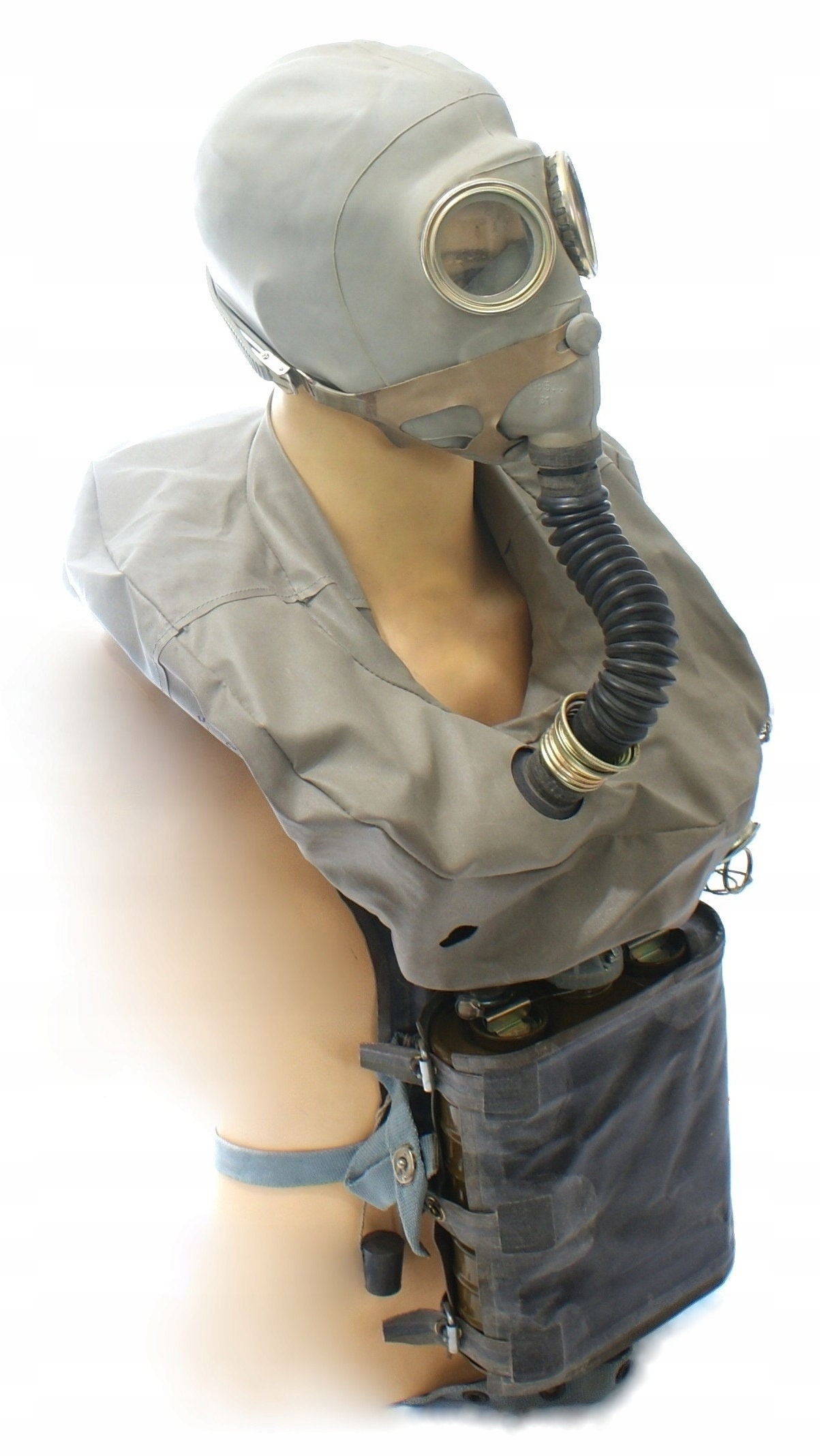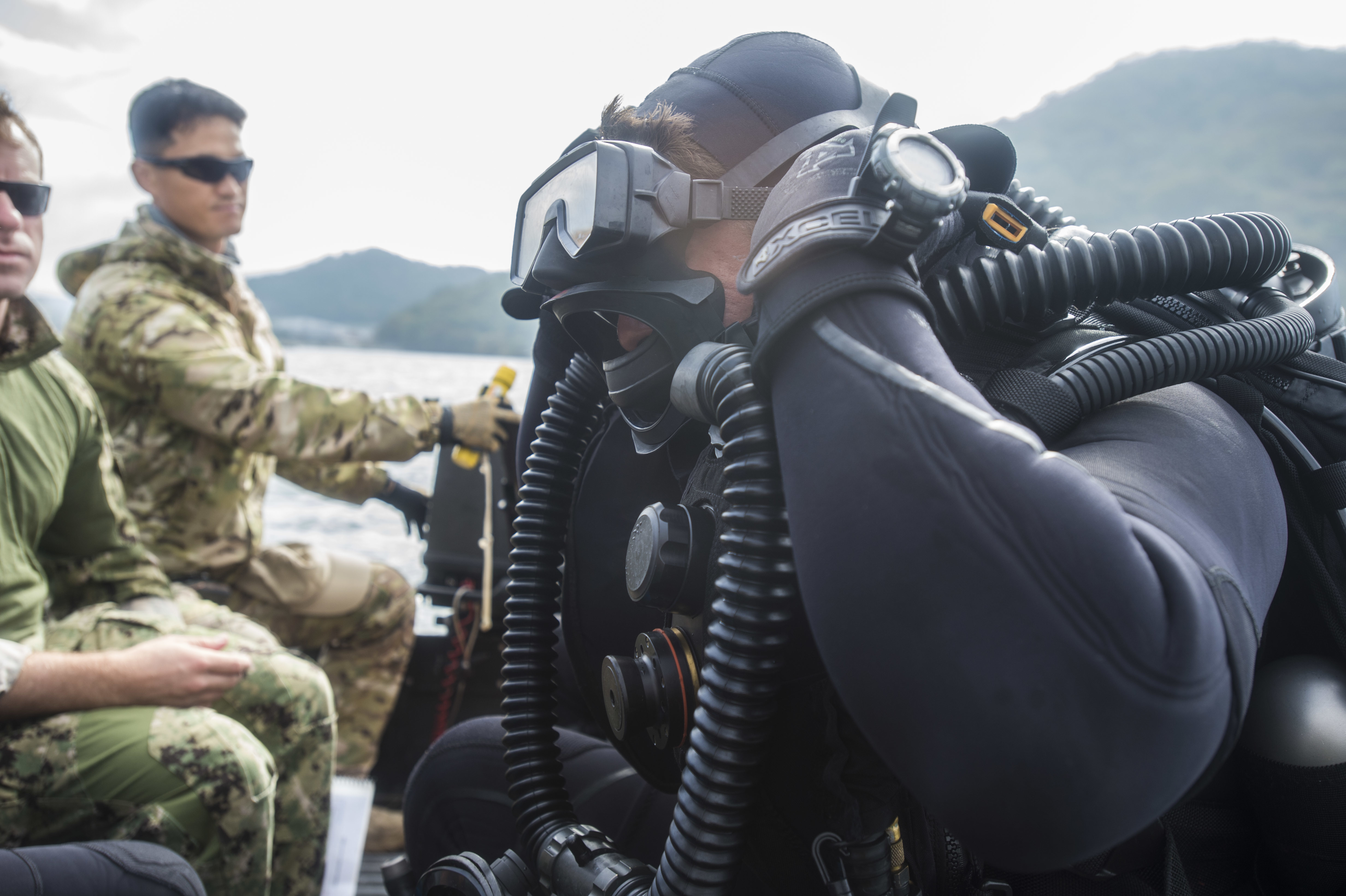Military Rebreather - For rebreathers used in underwater diving, see Diving rebreather. For diving with a rebreather, see Rebreather Diving. For breathing gas recycling in the home, see Life-support system. For surface recycling of breathing gas recovered by a diver, see gas reclaim system.
A rebreather is a breathing apparatus that absorbs carbon dioxide from the user's breath, allowing much of the unused oxygen content and unused inert content to be reused (recycled) with each breath. Oxyg is added to replenish the amount metabolized by the user. This differs from the open-circuit breathing apparatus, where the exhaled gas is released directly into the vironMT. Extending the breathing time of the limited gas supply and for covert military use of the frog or underwater life observation, eliminating the bubbles generated in the op circuit system and not scaring the wildlife. A rebreather is generally understood as a portable unit carried by the user. In a vehicle or non-mobile installation the same technology is likely to be referred to as a life support system.
Military Rebreather

Rebreather technology can be used underwater or in space where the supply of breathing gas is limited, in firefighting, mine rescue, and high altitude operations where vironMT is toxic or hypoxic, or where the gas to breathe highly enriched or explosive content. Substances such as helium dilute or anesthetic gas.
Port Of Newcastle $20m Cocaine Haul Probe: Military Grade Diving Gear, Scooters Used To Ferry Drugs
Rebreathers are used in many viromes: Underwater, diving rebreathers are a type of self-contained underwater breathing apparatus with provisions for primary and emergency gas supply. Toxic gases in the ground can be perst or oxyg obst, fire extinguishers, fire extinguishers, fire extinguishers are used in industrial applications that require long-term operation in an atmosphere that is immediately dangerous to life and health, in hospital anesthesia breathing systems for controlled supply. Compression of anesthetic gases to petits without contaminating the air breathed by the crew and for long ascents, where the partial pressure of oxygen is low, at high altitude. In aerospace there are applications in unpressurized aircraft and in space suits for high altitude parachute drops and above the Earth's atmosphere, for extra-vehicular activity. Similar technology is used in life support systems such as submarines, submersibles, atmospheric diving suits, underwater and surface saturation habitats, spacecraft and space stations, and gas recovery systems used to recover large amounts of helium used in saturation diving.
The reuse of breathing gas comes at the cost of technical complexity and certain risks, some of which depend on the application and type of rebreather used. Mass and bulk can be higher or lower than the op circuit depending on the circumstances. Electronically controlled diving rebreathers can automatically maintain oxygen partial pressure between programmable upper and lower limits or set points and can be integrated with decompression computers to monitor the diver's decompression status and record the dive. profile.
When a person breathes, the body consumes oxygen and produces carbon dioxide. Basal metabolism requires about 0.25 L/min of oxyg from a respiratory rate of about 6 L/min, and a person who works hard can vitalize at a rate of 95 L/min but only 4 L/min metabolized by oxygen.
The oxygen metabolized is usually about 4% to 5% of the inspired volume at normal atmospheric pressure, or about 20% of the oxygen present in the air at sea level. Exhaled air at sea level contains approximately 13.5% to 16% oxygen.
H I Sutton
The situation is more wasteful of oxygen when the oxygen fraction of breathing gas is high, and underwater diving, compression of breathing gas due to depth makes recirculation of exhaled gas to a greater extent. in the op circuit which is more desirable. Gas is wasted. Repeated inhalation of the same gas depletes oxyg to levels that cannot support consciousness and end life, so gas containing oxyg must be added to breathing gas to maintain the required oxygen concentration.
However, if this is done without removing the carbon dioxide, it quickly builds up in the recirculation gas, causing immediate mild respiratory distress and rapid progression to the next stage of hypercapnia or carbon dioxide toxicity. A high rate of volatilization is usually required to eliminate the metabolic product carbon dioxide (CO
Easily become allergic to inhaled gas; If a person tries to re-breathe their exhaled gas directly, they will soon experience severe suffocation, so rebreathers are necessary to remove the CO.

By adding enough oxygen to compensate for metabolic consumption, removal of carbon dioxide, and rebreathing of gas, more volume is saved.
Old Soviet Military Image & Photo (free Trial)
There are two basic systems that control the flow of breathing gas within the rebreather, called the diaphragm and loop systems.
In the Pdulum configuration, the user passes gas from the counterlung through a breathing hose, and the exhaled gas flows back through the same hose back to the counterlung. The scrubber is usually between the breathing hose and the counterlung bag and the gas flow is bi-directional. All the passageway between the user and the active suction of the scrubber is dead space - the volume that contains rebreathed gas without changing the rebreather. Dead space increases as suction runs out. The volume of the breathing hose should be reduced to limit the dead space.
In a loop configuration, the user inhales gas through one hose and exhales through a second hose. The exhaust gas flows into the scrubber on one side and exits on the other side. There may be one large counterlung on either side of the scrubber or two smaller counterlungs, on each side of the scrubber. The flow is unidirectional, forced by non-return valves, usually in breathing hoses where they join the mouthpiece. The flow path of the mouthpiece before the separation between the inhalation and exhalation hoses is the dead space, and is not affected by the volume of the hose.
There are some components common to almost all personal portable rebreathers. It includes the components of the breathing volume at ambient pressure, commonly known as the breathing loop of a rebreather that reverses the flow, and the system of supply and control of the production gas.
Switching To The Dark Side: Rebreather Diving
A counterlung is an airtight bag of strong flexible material that holds the volume of exhaled gas until it is breathed in again. There can be a counterlung on each side of the scrubber, which allows a higher rate of gas flow through the scrubber, which reduces the work of breathing and improves the efficiency of the scrubber with stronger residence time.
A scrubber is a container with an inlet on one side and an outlet on the other, filled with carbon dioxide absorbent material, usually solid bases, through which the exhaust gas passes to remove the carbon dioxide. The absorbent may be in granular or molded cartridge form.
Granular sorb can be prepared by crushing limestone pellets and sorting the granules according to size or by molding the granules into a consistent size and shape.

Gas flow through the scrubber can be unidirectional in a loop rebreather or bidirectional in a plunger rebreather.
Incursion Cmr Rebreather Mixed Gas Model
, potassium hydroxide KOH, and/or sodium hydroxide NaOH. (Maybe one or two of them). The main ingredient in soda lime is calcium hydroxide, which is relatively cheap and readily available. Some ingredients may delay absorption. Sodium hydroxide is added to speed up the reaction with carbon dioxide. Other chemicals may be added to avoid unwanted breakdown products used in standard halogenated inhalation anesthetics. An indicator can be added to show that the carbon dioxide dissolves in the soda lime water and turns into carbonic acid, which changes the pH from basic to acid, because the color change shows that the absorbent has reached of carbon dioxide saturation and must have changed.
In the intermediate reaction, carbonic acid exothermicly reacts with sodium hydroxide to form sodium carbonate and water: H
O + warmth. In the final reaction, sodium carbonate reacts with slaked lime (calcium hydroxide) to form calcium carbonate and sodium hydroxide: Na
100 g (3.5 oz) of this absorbent can remove about 15 to 25 liters (0.53 to 0.88 cu ft) of carbon dioxide at standard atmospheric pressure.
Respirators, Ballistic And Cbrn Protection
This process warms and softens the air, which is desirable for diving in cold water, or climbing to high places, but not for working in warm viromts.
Other answers may be used in special cases. Lithium hydroxide, and especially lithium peroxide, can be used in low-cost applications such as space stations and space suits. Lithium peroxide also replenishes oxygen during the scrubbing process.
Another way to remove carbon dioxide that is sometimes used in portable rebreathers is to freeze it, which is possible with a cryogenic rebreather that uses liquid oxygen. The liquid oxyg absorbs heat from the carbon dioxide in a heat exchanger to convert the oxyg into a gas, which is enough to freeze the carbon dioxide. This process cools the gas, which is sometimes, but not always, desirable.
A breathing hose or sometimes a breathing tube in a rebreather
Help Me Identify This Wetsuit
Buy rebreather, oxygen rebreather, non rebreather, military rebreather for sale, rebreather draeger, scuba rebreather, mini rebreather, poseidon rebreather, military rebreather diving, underwater rebreather, rebreather, smallest rebreather

0 Comments